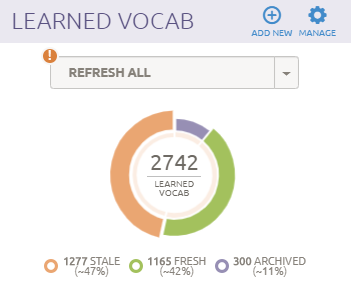Only have 10 minutes to spend on language learning today? Refresh your Learned Vocab. Posted by Transparent Language on Oct 6, 2020 in For Learners, Learning + Usage Tips
As you probably know, language learning takes time and effort. Some days you’ll only have 10 minutes to spare, but you can make those 10 minutes count with Learned Vocab refresh.
Refresh your learned vocab.
Research consistently shows that proficiency levels increase in tandem with vocabulary size.1,2,3 In fact, of all factors contributing to language proficiency, vocabulary size is by far the single most significant factor.4,5,6
Needless to say, maintaining your vocabulary is an important part of maintaining proficiency. But thousands of paper flashcards would be inefficient to create, organize, and carry around.
Transparent Language Online makes it effortless to organize and review with your Learned Vocab: your personal collection of words and phrases you’ve learned.
Optimize your time.
Easily organize all your vocabulary in one place. Vocab from Transparent Language Online lessons you complete are automatically added to your that collection, where it can easily be reviewed or automatically refreshed. Of course, not all learning happens in the Transparent Language Online, so you can also easily add your own Learned Vocab from news articles, podcasts, and elsewhere—then refresh it all in one place, whenever you have a few minutes.
Know when and what to review to maximize your time. Learned Vocab’s spaced repetition algorithm helps you review the right vocab at the right time, so you’re not neglecting the “stale” vocabulary that you’re most at risk of forgetting. You can also “archive” words or phrases you know extremely well, ensuring you’ll only refresh what you need.
How does it work?
Unless you choose your items manually, the algorithm will challenge you to remember and produce the words and phrases you likely most need to review now. You’ll see your known language, then think the target language to yourself, or even better say it aloud. Then self-report whether you remembered it correctly.
If you knew it, you’ll see it again some weeks or months down the line. If you didn’t remember, you’ll re-learn it right then, and if you refreshing regularly, you’ll see it again in just a few days.
Sources:
1. Huhta, Ari J. et al. (2011) Diagnosing reading in L2 – predictors and vocabulary profiles, Vortrag auf der ACTFL CEFR Conference 2011, 4.-6. August 2011, Provo, Utah (USA).
2. Milton, J., & Alexiou, T. (2010). Developing a vocabulary size test for Greek as a foreign language
3. Tschirner, E., J. Hacking, and F. Rubio. (2017). Relating Vocabulary Size to ACTFL Reading Proficiency Levels. Conference Paper, Refereed. ACTFL Annual Convention. Nashville, TN., 2017
4. Alderson, J.C. (2005). Diagnosing foreign language proficiency. London: Continuum.
5. Laufer, B. (1992). How much lexis is necessary for reading comprehension? In H. Bejoint & P. Arnaud (Eds.), Vocabulary and applied linguistics (pp. 126–132). London: Macmillan.
6. Stæhr, L. S. (2008). Vocabulary size and the skills of listening, reading and writing. Language Learning Journal, 36(2), 139-152.

Build vocabulary, practice pronunciation, and more with Transparent Language Online. Available anytime, anywhere, on any device.





Leave a comment: